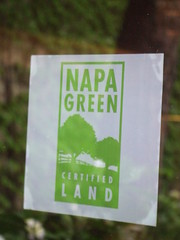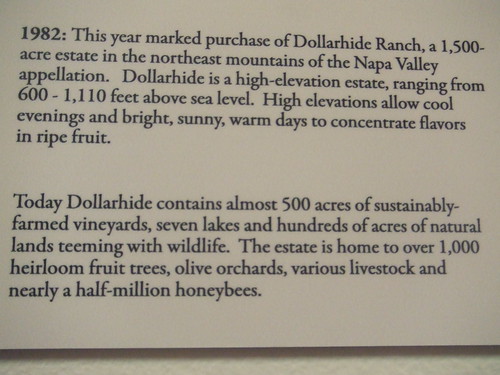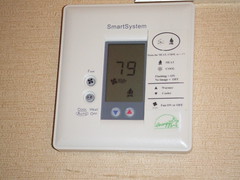For part one of my photo-essay, click here.
 When doing my research for my trip to California, as you may recall, I found a very short list of organic vineyards in Napa Valley; however, once we arrived, signs such as this one were discretely posted at the majority of the vineyards we visited. I was pleased to find that my trip was going to be even more eco-friendly than I had anticipated, since I had assumed the majority of the vineyards would not grow organic grapes. Vineyards are large and difficult to maintain as it is, after all, so I had expected organic farming to be a rarity.
When doing my research for my trip to California, as you may recall, I found a very short list of organic vineyards in Napa Valley; however, once we arrived, signs such as this one were discretely posted at the majority of the vineyards we visited. I was pleased to find that my trip was going to be even more eco-friendly than I had anticipated, since I had assumed the majority of the vineyards would not grow organic grapes. Vineyards are large and difficult to maintain as it is, after all, so I had expected organic farming to be a rarity.
 However, the more of these signs I saw, the more I began to wonder about their true meaning. What does “Napa Green Certified Land” actually mean? Often, things are labeled as “green” or “eco-friendly” or “organic” despite being none of those things, though standards and certification for organic products are becoming more rigorous. So, I decided to do some research to find out if wineries had to go through a legitimate process to become “Napa Green Certified Land,” or if any old vineyard could order that sticker and put it up in their window.
However, the more of these signs I saw, the more I began to wonder about their true meaning. What does “Napa Green Certified Land” actually mean? Often, things are labeled as “green” or “eco-friendly” or “organic” despite being none of those things, though standards and certification for organic products are becoming more rigorous. So, I decided to do some research to find out if wineries had to go through a legitimate process to become “Napa Green Certified Land,” or if any old vineyard could order that sticker and put it up in their window.
I found that Napa Green is a voluntary program that vintners can join and is intended to surpass the standards of state and federal “best practices.” Vineyards and others who join are certified by a third party, which guarantees objectivity, though I could not find out who that third party was, and that third party ensures that the vintners use practices that protect the ecological quality of the valley. Since Napa Green is a public-private partnership, it not only promotes higher environmental standards but is beneficial to the community. I was pleasantly surprised to find that several of the vineyards I visited were listed as Napa Green Certified Land and/or Napa Green Certified Vineyards, even though I only saw the sticker in the window of one winery.
 In fact, many of the vineyards we visited were very secretive about their growing practices. That last paragraph, which comes from a plaque in St. Supery winery, was the only indication I found that the growers practiced sustainable farming. At Domaine Carneros, I would have had no idea that they used organic grapes if our pourer hadn’t chanced to tell us that Domaine Carneros was the first sparkling winery in the US to have all of its estate vineyards receive organic certification, and I would not have known about their large solar collection system if I hadn’t looked on their website to verify the organic certification. Other vineyards were even more secretive; Sterling Vineyards, Robert Mondavi Winery, Cakebread Cellars, and Beringer Vineyards were all on the Napa Green certified list, and yet while I was tasting at those wineries I had no idea that they were committed to organic and sustainable farming. I suppose I should have asked the pourers whether or not the grapes were organic, but I assumed that they wouldn’t know the right answer. I guess the best thing you can do no matter where you are is ask, if you’re really committed to organic products.
In fact, many of the vineyards we visited were very secretive about their growing practices. That last paragraph, which comes from a plaque in St. Supery winery, was the only indication I found that the growers practiced sustainable farming. At Domaine Carneros, I would have had no idea that they used organic grapes if our pourer hadn’t chanced to tell us that Domaine Carneros was the first sparkling winery in the US to have all of its estate vineyards receive organic certification, and I would not have known about their large solar collection system if I hadn’t looked on their website to verify the organic certification. Other vineyards were even more secretive; Sterling Vineyards, Robert Mondavi Winery, Cakebread Cellars, and Beringer Vineyards were all on the Napa Green certified list, and yet while I was tasting at those wineries I had no idea that they were committed to organic and sustainable farming. I suppose I should have asked the pourers whether or not the grapes were organic, but I assumed that they wouldn’t know the right answer. I guess the best thing you can do no matter where you are is ask, if you’re really committed to organic products.
 Another thing you can do, no matter where you are, is turn off the heating/air conditioning when you leave the hotel room. We got lucky in one of our hotels; our heating and air was controlled by the energystar SmartSystem in the picture, which had ‘sleep’ and ‘away’ settings that allowed you to enter how long you would be gone so that the air would turn off for that period and click back on once you returned to the room. Even without that feature, however, it isn’t difficult to turn off the heat/air whenever you leave. Also remember to turn off all the lights before you leave, just as you should before you leave your house to go on vacation (or any time you leave your house, really). We put some of our lights on light timers to make sure that they would come on periodically while we were gone as a burglary deterrent, but the lights only go on for an hour or two every night and the rest of the house remains dark. And, as a bonus, turning off the lights and the air helps your wallet as well as the environment!
Another thing you can do, no matter where you are, is turn off the heating/air conditioning when you leave the hotel room. We got lucky in one of our hotels; our heating and air was controlled by the energystar SmartSystem in the picture, which had ‘sleep’ and ‘away’ settings that allowed you to enter how long you would be gone so that the air would turn off for that period and click back on once you returned to the room. Even without that feature, however, it isn’t difficult to turn off the heat/air whenever you leave. Also remember to turn off all the lights before you leave, just as you should before you leave your house to go on vacation (or any time you leave your house, really). We put some of our lights on light timers to make sure that they would come on periodically while we were gone as a burglary deterrent, but the lights only go on for an hour or two every night and the rest of the house remains dark. And, as a bonus, turning off the lights and the air helps your wallet as well as the environment!
 In conclusion, no matter where you go on your next vacation there are dozens of things you can do to make your travels more eco-friendly. Pack light, eat local, patronize local businesses (including wineries!) and businesses that are committed to organic products, turn off the lights, and take local/mass transit. And as my own winery adventures prove, sometimes you will be surprised by how many of the places you visited use organic and sustainable practices. I hope this photo-essay has helped inspire you to take steps towards your own eco-friendly vacation!
In conclusion, no matter where you go on your next vacation there are dozens of things you can do to make your travels more eco-friendly. Pack light, eat local, patronize local businesses (including wineries!) and businesses that are committed to organic products, turn off the lights, and take local/mass transit. And as my own winery adventures prove, sometimes you will be surprised by how many of the places you visited use organic and sustainable practices. I hope this photo-essay has helped inspire you to take steps towards your own eco-friendly vacation!


